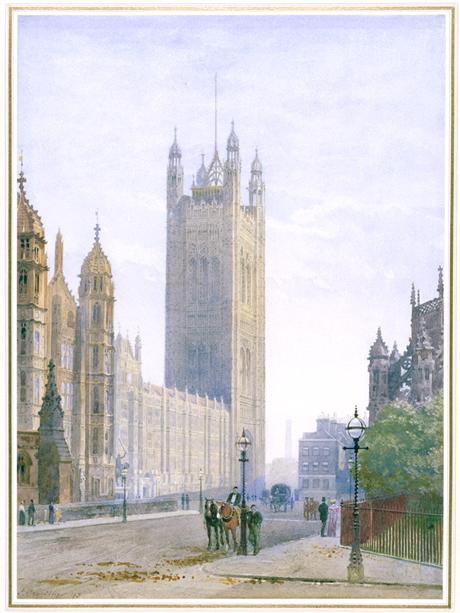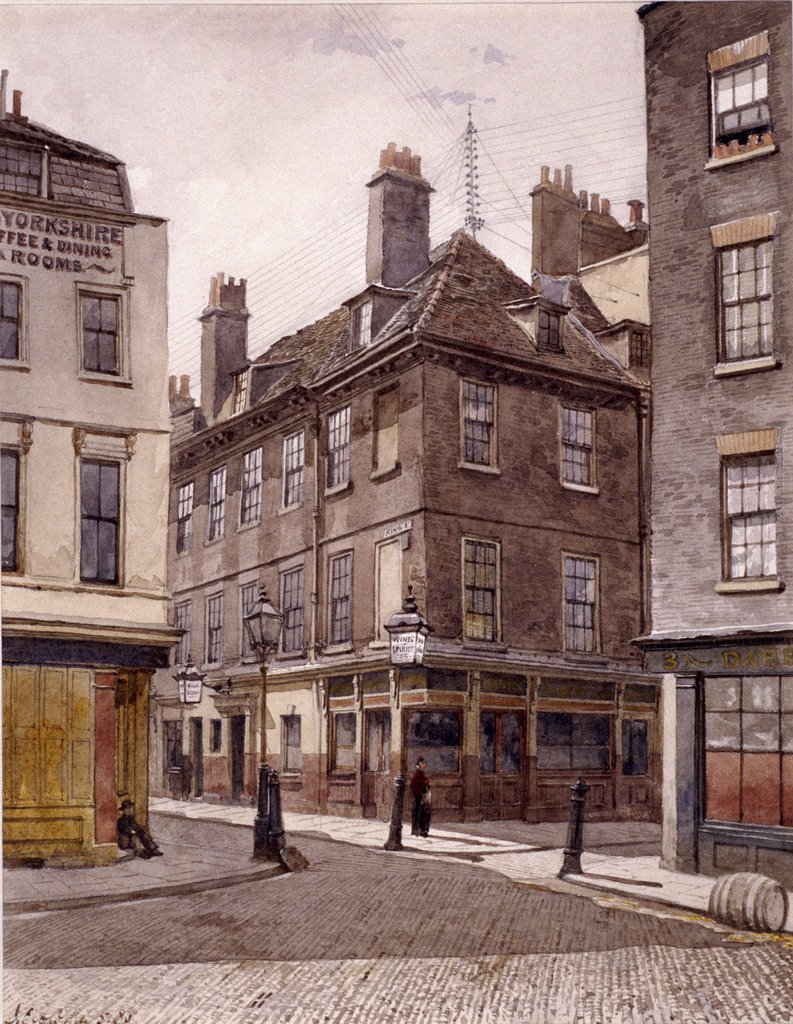“When a man is tired of London, he is tired of life; for there is in London all that life can afford.” – Samuel Johnson
 |
| The Victoria Tower of the Houses of Parliament seen from Parliament Square Watercolour John Crowther (1837–1902) |
This famous quote reminds us how full of life and variety London is. There
is something for everyone in this great city—whether it’s art, culture,
history, or everyday life. London is a city that never fails to impress. No
matter how often you walk its streets, you will always find something new and
interesting. From grand buildings to narrow alleys, from quiet parks to busy
markets, London is a place full of surprises and stories.
Some of the most beautiful memories of old London come to us through the
work of painters. These artists captured the city on canvas, allowing us to see
what London looked like many years ago. Even today, when we look at these
paintings, we can imagine the life, the people, and the atmosphere of London in
the past. These works of art help us understand how the city has changed, but
also how much it has remained the same in spirit.
 |
| View of the Junction of Howard Street and Norfolk Street, London, 1880 John Crowther |
One artist who painted many views of London was John Crowther. He
was born in 1837 and died in 1902. Crowther made many paintings of London, and
his work gives us a very good look at how the city looked during the 19th
century. His watercolour paintings are full of detail and emotion. He did not
just paint buildings; he painted the feeling of the city, the way people lived,
and how the streets looked during his time.
The Victoria Tower of the
Houses of Parliament
Let’s start by looking at one of Crowther’s beautiful works: the Victoria
Tower of the Houses of Parliament, as seen from Parliament Square.
This tower is part of the larger building that many people call the House of
Parliament, also known as Westminster Palace. The painting was made
in 1893, and it shows the tower as it looked back then. When we look at this
artwork, we see not only a building, but also the style, the mood, and the
light of that time.
The Victoria Tower is a tall and powerful-looking structure. It stands
proudly at the southwest end of the Palace of Westminster. In the painting, the
sky behind the tower is soft and cloudy, and the colours are gentle and calm.
There are some people walking in the square, dressed in the clothes of the late
19th century. Horses and carriages can also be seen in the distance. This
painting gives us a quiet and peaceful view of a very important part of the
city.
In the late 1800s, London was growing fast. New buildings were coming up,
and old ones were being repaired or taken down. Still, many parts of the city,
like the Houses of Parliament, stayed the same in appearance. They were symbols
of power, history, and national pride.
Crowther painted this scene with great care. You can tell that he wanted to show not just the tower, but also the feeling it gave to the people who saw it. If you were standing there in 1893, this is what you might have seen. Thanks to this painting, we too can now share that experience.
Howard Street and Norfolk
Street, London (1880)
Now let’s look at another painting by Crowther. This one shows the junction,
or meeting point, of Howard Street and Norfolk Street, painted in the
year 1880. These two streets were once located near the Strand, a busy and
important part of central London. For about 200 years, this area was part of
the very heart of London.
At first, the painting might seem simple—just a few buildings and streets.
But if you look closely, you will notice many interesting details. The layout
of the streets, the placement of the footpaths, the shape of the shop windows,
and the way the buildings are built all tell us something about city life in
the 19th century.
This part of London had a mix of homes, shops, and small businesses. It was
a working area where many ordinary Londoners lived and worked. The buildings
were tall and narrow, and some of them had signs above the doors showing what
kind of goods were sold inside. People would have walked here every day on
their way to work, or to buy food, clothes, and other goods.
At the time Crowther painted this, London was undergoing big changes. The
city was growing rapidly due to industrialization. Many older buildings and
streets were being torn down to make space for new roads, offices, and railway
lines. Crowther was actually hired to paint scenes like this so that future
generations could see what was being lost.
Sadly, this area was eventually demolished and rebuilt in the 20th century.
Today, it looks completely different. But thanks to Crowther’s work, we can
still see what it looked like in 1880.
King Street, Stepney
 |
| King Street, Stepney, London John Crowther |
The next painting shows a very different part of the city. This is King
Street, located in Stepney, a district in East London. This was not
a rich part of the city. Here, the people were mostly workers—men and women who
lived in small houses and worked long hours in factories, warehouses, and
markets.
In this painting, Crowther shows us the daily life of ordinary people. There are women in long skirts, boys playing on the street, and men going about their business.
The houses are small and close together. Some look run-down.
But there is also a sense of community. People knew each other, helped each
other, and shared their lives on streets like these.
During the reign of Queen Victoria, London was at the center of the
British Empire. Trade was booming, and goods were coming in and out of the city
from all over the world. Riches flowed into England, and London was filled with
shops selling fine clothes, spices, furniture, and more. But not everyone
benefited equally.
While the rich lived in grand houses in the West End, many of the poor
lived in places like Stepney. Life here was tough. Jobs were hard, and pay was
low. Still, people made the best of what they had. They built strong families,
supported each other, and tried to give their children a better future.
Crowther’s painting does not hide the poverty, but it also does not paint
the people as helpless or hopeless. Instead, it shows their strength and pride.
The scene is quiet, simple, and real. We can feel the life of the street, just
as it was more than a hundred years ago.
The British Empire and Daily
Life
At the time these paintings were made, the British Empire was the
largest empire in the world. It controlled vast parts of Africa and Asia,
including India, which was known as the “jewel in the crown” of the
empire. The goods, wealth, and resources from these lands were sent to Britain.
Ships carried spices, tea, cotton, timber, and many other products to English
ports.
This wealth helped build many of the beautiful homes, parks, and public
buildings that we see in Crowther’s paintings. Timber from South Asia was used
to build furniture and decorate homes. Fine clothes were made from cotton grown
in India. The empire brought great riches to Britain, though it also caused
much pain and hardship in the countries that were ruled by it.
British soldiers and officials controlled large parts of the world. The
power of the empire was maintained through its navy, its army, and its trade
routes. While some people in Britain became rich, many people in the colonies
remained poor.
The paintings we have looked at show both the beauty and the reality of
life in London during this time. The buildings are grand, but the people in the
streets remind us of the hard work that kept the city running. Behind every
beautiful house and well-dressed man was a world of labor, trade, and empire.
Piccadilly Circus – George Hyde Pownall
 |
| Piccadilly Circus George Hyde Pownall |
Another artist who painted London around this time was George Hyde
Pownall. One of his most famous works shows Piccadilly Circus, one
of London’s most famous and lively places. Unlike Crowther’s quiet streets,
this painting is full of movement and light. People are walking, talking, and
hurrying to their destinations. Horse-drawn carriages move through the traffic.
The buildings are lit up, and everything seems to be moving quickly.
Piccadilly Circus has always been a centre of London life. Located in the
West End, it is surrounded by theatres, shops, and restaurants. In Pownall’s
time, it was already a busy place. People from all over the city came here to
enjoy the lights, the shows, and the energy of city life.
The painting captures this excitement. The sky is dark, but the city glows
with lights. You can almost hear the noise—the wheels, the horses, the voices
of the crowd. It is a different side of London, more modern and fast-paced, but
still full of charm.
Conclusion: The Life and
Charm of London
So what do these paintings tell us? They show us that London was and
still is a city full of life. It has a rich history, beautiful buildings, and
busy streets. It has both quiet corners and loud, lively squares. It has
wealthy areas and working-class neighbourhoods. It is a city of contrasts, and
that is part of what makes it so special.
Through the eyes of painters like John Crowther and George Hyde Pownall, we
can see the London of the past. We can walk its streets, stand in its squares,
and feel the life of the people who lived there. These paintings are not just
pictures—they are windows into history.
No matter how much London changes, it always holds on to its spirit. That
spirit is captured in these works of art. It is a city that has welcomed people
from all over the world. It is a place where history and modern life meet every
day.
So, as Samuel Johnson said, if a man is tired of London, he is tired of
life. Because in London, you can find everything life has to offer—beauty,
struggle, hope, change, and the endless rhythm of a great city.